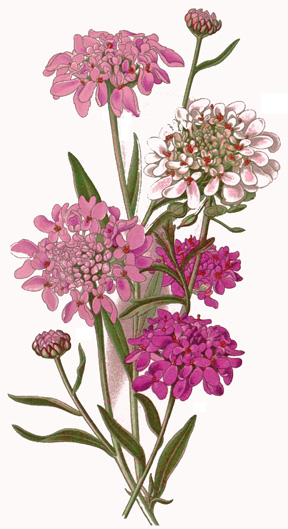 Iberis umbellata
Iberis umbellataCandytuft
Candytuft been grown in the US since the colonial period and in European gardens since the late 16th century; the British herbalist John Gerard was the first to cultivate it. It's a great choice for cottage gardens because of its history, its fragrant flowers, and the use of its mustardy seeds as a savory flavoring. In the language of flowers, candytuft stands for indifference, and because of that, it is a good candidate for breaking binding love spells--it combines the heat of Mars in its seeds with the sweetness of Venus in its flowers (and in its name referring to the birthplace of Aphrodite), and it's "indifferent" about where it grows. Just take a look at some of the poems associated with it below. In herbalism, the seeds were a treatment for rheumatism, and the fresh leaves were used as a counterirritant for sciatica. The seeds of this member of the broccoli family were eaten with meat in the Elizabethan period. The "candy" of candytuft refers to an area of the Mediterranean now known as Crete; it's a native of Southern Europe (Iberis = Iberia, Spain).Candytuft is also known as candy mustard, Spanish tufts, sciatic cress, globe candytuft, rocket candytuft, common purple candy tuft, billy-come-home-soon, and Iberis corymbosa. Top
How to Grow Candytuft
Start indoors 6 weeks before your last frost for optimal growth. Barely cover
seed to germinate in 2-3 weeks at room temperature. Like many annuals,
candytuft prefers full sun. It can grow in partial shade but won't
have as many flowers. The fragrant blooms can be white, pink, or
violet. It flowers from spring to July, takes a rest during the
heat of summer, and then reblooms in fall. Pick off the dead flowers
(deadhead) to get more blooms. It gets 12-20"/30-50cm; space
8-10" apart. It likes to grow in chalky, dryish soils, so siting
it next
to concrete or rocks is good. Bees and butterflies enjoy the flowers.
It can be a perennial in warm, dry regions (doesn't like heat +
humidity). Harvest the pods when brown to get the seeds. You can
hang the tops upside-down in a bag to make it easier, or just crack
the pods apart. This plant can reseed readily. General
growing info Top
Poems related to candytuft:
Better the tie at once be broken,
At once our
last farewell be spoken,
Than watch him, one by one, destroy
The
glowing buds of hope and joy--
Than thus to see them, day by
day,
Beneath his coldness fade away.
---F.S.Osgood
Thou ne'er didst love!
'T is writ in the
smooth margin of thy brow,
And in the steady lustre of thine
eye.
Thy blood did never riot in thy veins
With the distempered,
hurried course of love;
Thy heart did never shake thy shuddering
frame
With the thick, startled, throbbing pulse of love;
Thou
has ne'er wept love's bitter, burning tears,
Hoped with love's
wild, unutterable hope,
Nor drowned in love's dark, fathomless
despair.
Thine is a steadfast and a fixed nature
'Gainst which
the tide of passion and desire
Breaks harmless as the water o'er
the rock:
And the rich light of beauty shines alone
On thy
soul's surface, leaving all beneath it
Unmoved and cold as subterranean
springs.
Love has no power o'er spirits such as thine,
Nor
comes it nigh to them.
--Mrs. P. Butler
Iberis umbellata
Candytuft
75 seeds $3.75
Uses in Witchcraft & Magic:
Breaking Love Spells
Mars/Venus Herb
© 2016-2024 Alchemy Works; No reproduction without permission